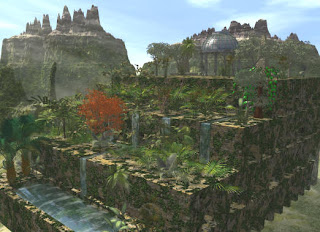The Hanging Garden of Babylon
The Hanging Garden of babylon also known as the Hanging garden of Semiramis, near present-day Al-Hillah, Babil in Iraq, are considered to be one of the original Seven Wonders of Ancient World. They were built by the Chaldean king Nebuchadnezzar around 600 BC. He is reported to have constructed the gardens to please his homesick wife, Amytis of Media who longed for the trees and fragrant plants of her homeland Persia. The gardens were destroyed by several earthquakes after the 2nd century BC.The lush Hanging Gardens are extensively documented by Greek Historian such as Strabo and Diodorus. Through the ages, the location may have been confused with gardens that existed at Nimrud since tablets from there clearly show gardens. Writings on these tablets describe the possible use of something similar to an Archimedes screw as a process of raising the water to the required height. Nebuchadnezzar II also used massive slabs of stone, which was unheard of in Babylon, to prevent the water from eroding the ground.
There is some controversy as to whether the Hanging Gardens were an actual creation or a poetic creation due to the lack of documentation of them in the Chronicles of Babylonian history. In ancient writings the Hanging Gardens of Babylon were first described by Berossus, a Chaldean priest who lived in the late 4th century BC. These accounts were later elaborated on by Greek historians.A more recent theory proposes that the gardens were actually constructed under the orders of Sennacherib, who took the throne of Assyria in 705 BC, reigning until 681 BC. During new studies of the location of Nineveh (Located on the eastern bank of the Tigris in ancient Assyria) his gardens were placed close to the entrance of his palace, on the bank of the River Tigris. It is possible that in the intervening centuries, the two sites became confused, and the hanging gardens were attributed to Babylon.
Greek References :
The Greek Historian Strabo :
"Babylon, too, lies in a plain; and the circuit of its wall is three hundred and eighty-five stadia. The thickness of its wall is thirty-two feet; the height thereof between the towers is fifty cubits that of the towers is sixty cubits; the passage on top of the wall is such that four-horse chariots can easily pass one another; and it is on this account that this and the hanging garden are called one of the Seven Wonders of the World. The garden is quadrangular in shape, and each side is four plethra in length. It consists of arched vaults, which are situated, one after another, on checkered, cube-like foundations. The checkered foundations, which are hollowed out, are covered so deep with earth that they admit of the largest of trees, having been constructed of baked brick and ashpalt the foundations themselves and the vaults and the arches. The ascent to the uppermost terrace roofs is made by a stairway; and alongside these stairs there were screws, through which the water was continually conducted up into the garden from the Euphrates by those appointed for this purpose. For the river, a stadium in width, flows through the middle of the city; and the garden is on the bank of the river.
The Greek Historian Diodorus:
"The Garden was 100 feet (30 m) long by 100 ft wide and built up in tiers so that it resembled a theatre. Vaults had been constructed under the ascending terraces which carried the entire weight of the planted garden; the uppermost vault, which was seventy-five feet high, was the highest part of the garden, which, at this point, was on the same level as the city walls.The roofs of the vaults which supported the garden were constructed of stone beams some sixteen feet long, and over these were laid first a layer of reeds set in thick tar, then two courses of baked brick bonded by cement, and finally a covering of lead to prevent the moisture in the soil penetrating the roof. On top of this roof enough topsoil was heaped to allow the biggest trees to take root. The earth was leveled off and thickly planted with every kind of tree. And since the galleries projected one beyond the other, where they were sunlit, they contained conduits for the water which was raised by pumps in great abundance from the river, though no one outside could see it being done.




















